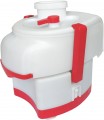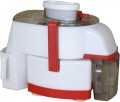Juice container
The volume of the built-in or freestanding juice tank (see Juice capacity). It is usually in the range from 0.2 to 2 liters. Doing more volumes, usually, does not make sense — freshly squeezed juice is considered the most useful, and it quickly loses its properties. Therefore, the best option is to prepare small portions of juice
up to 1 liter, with the expectation that you can drink it right away. On the other hand, for the preparation of canned juices,
a tank volume of 1.5 – 2 liters is usually quite enough.
Pulp container
The volume of the tank for the oil cake (pressed pulp) installed in the juicer.
While most models with a pulp tank come equipped with an automatic pulp ejection function (see "Functions"), there are some exceptions. Nevertheless, the size of the tank directly affects the duration for which the juicer can be used without having to empty the oil cake residue. However, an increase in capacity significantly impacts the device's dimensions, weight, and cost.
Modern juicers are designed with oil cake containers ranging from 200-500 mL in the most compact models to 3 liters or more in larger ones. The specific capacity is usually chosen by designers based on the unit's total power and performance. However, models with similar performance characteristics may differ in their oil cake container volume. When selecting a juicer, it's important to consider the intended use of the device. For occasional home use, a smaller container may suffice, but for a cafe or bar where freshly squeezed juices are prepared regularly, a larger capacity juicer may be the better option.

